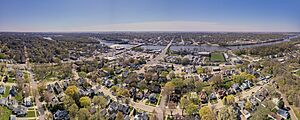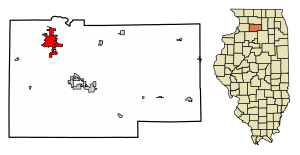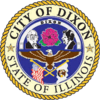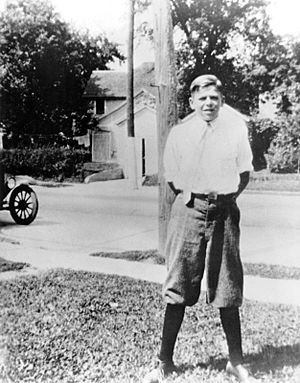Dixon, Illinois facts for kids
Quick facts for kids
Dixon, Illinois
|
|||
|---|---|---|---|

Aerial view of Dixon, Illinois
|
|||
|
|||
| Nickname(s):
Petunia City
|
|||

Location of Dixon in Lee County, Illinois
|
|||
| Country | United States | ||
| State | Illinois | ||
| County | Lee | ||
| Area | |||
| • Total | 8.79 sq mi (22.76 km2) | ||
| • Land | 8.48 sq mi (21.96 km2) | ||
| • Water | 0.31 sq mi (0.80 km2) | ||
| Elevation | 712 ft (217 m) | ||
| Population
(2020)
|
|||
| • Total | 15,274 | ||
| • Density | 1,801.60/sq mi (695.64/km2) | ||
| Time zone | UTC−6 (CST) | ||
| • Summer (DST) | UTC−5 (CDT) | ||
| ZIP Code(s) |
61021, 61022, 61023
|
||
| Area code(s) | 815 | ||
| FIPS code | 17-20162 | ||
| GNIS ID | 2394537 | ||
| Wikimedia Commons | Dixon, Illinois | ||
Dixon is a city in Lee County, Illinois, United States. It is also the county seat, which means it's where the county government is located. In 2020, about 15,274 people lived there. The city gets its name from its founder, John Dixon. He used to run a ferry service across the Rock River, which flows through the city.
Dixon is known as the "Petunia Capital of Illinois" and "The Catfish Capital of Illinois." It was also the childhood home of Ronald Reagan, who later became the 40th U.S. President. You can find the Lincoln Monument State Memorial in Dixon. This monument shows where Abraham Lincoln joined the Illinois militia in 1832 during the Black Hawk War.
Contents
Dixon's History
Around 1828, a man named Joseph Ogee started a ferry service and built a cabin by the Rock River. In 1830, John Dixon bought Ogee's Ferry and moved his family there. Soon after, the local post office was renamed "Dixon's Ferry."
Key Events in Dixon's Past
On May 4, 1873, the Truesdell Bridge in Dixon collapsed. This sad event happened while many people were on the bridge watching a baptism.
There's a road near Interstate 88 called Bloody Gulch Road. This road got its name from a historical event in 1885. A farmhand was involved in a serious incident with a traveling salesman. The farmhand was later found guilty and sent to jail. The road over the underpass then became known as Bloody Gulch Road.
In 2012, a city official in Dixon was found to have taken a large amount of money from the city. This was a very serious problem for Dixon's finances. However, the city worked hard to get money back from the auditors and banks involved. They received about $40 million in settlements, which helped the city recover. The person responsible was sentenced to prison.
On May 16, 2018, a student fired shots inside Dixon High School during a graduation practice. A school police officer, Mark Dallas, quickly responded. He chased the student and, after shots were fired, the officer wounded the shooter. The student was then taken into custody. Thanks to the officer's quick actions, no one else was hurt.
Ronald Reagan's Boyhood Home
Dixon was the childhood home of Ronald Reagan, who became the 40th President of the United States. He was born in nearby Tampico and moved to Dixon when he was nine years old. As a teenager, he worked as a lifeguard along the Rock River.
Reagan's family home at 816 South Hennepin Avenue is now preserved. It is called the Ronald Reagan Boyhood Home. In 1984, while he was president, Reagan returned to Dixon to celebrate his 73rd birthday. He visited his old home, and the city held a parade in his honor.
Dixon's Geography
Dixon covers an area of about 7.86 square miles (22.76 square kilometers). Most of this area is land, with a small part being water.
Dixon's Climate
Dixon has a climate with four distinct seasons. Winters are usually cold with snow, and summers are warm and humid. Temperatures in Dixon typically range from about 10°F (-12°C) in winter to 82°F (28°C) in summer. The coldest temperature ever recorded was -32°F (-35°C), and the hottest was 110°F (43°C).
| Climate data for Dixon, Illinois (1991–2020 normals, extremes 1893–present) | |||||||||||||
|---|---|---|---|---|---|---|---|---|---|---|---|---|---|
| Month | Jan | Feb | Mar | Apr | May | Jun | Jul | Aug | Sep | Oct | Nov | Dec | Year |
| Record high °F (°C) | 65 (18) |
71 (22) |
87 (31) |
93 (34) |
105 (41) |
106 (41) |
110 (43) |
103 (39) |
102 (39) |
95 (35) |
81 (27) |
68 (20) |
110 (43) |
| Mean daily maximum °F (°C) | 29.0 (−1.7) |
33.6 (0.9) |
46.3 (7.9) |
59.9 (15.5) |
71.0 (21.7) |
79.8 (26.6) |
82.7 (28.2) |
81.4 (27.4) |
75.3 (24.1) |
62.8 (17.1) |
47.6 (8.7) |
34.5 (1.4) |
58.7 (14.8) |
| Daily mean °F (°C) | 21.3 (−5.9) |
25.5 (−3.6) |
37.3 (2.9) |
49.4 (9.7) |
60.9 (16.1) |
70.2 (21.2) |
73.5 (23.1) |
71.9 (22.2) |
64.6 (18.1) |
52.4 (11.3) |
39.0 (3.9) |
27.3 (−2.6) |
49.4 (9.7) |
| Mean daily minimum °F (°C) | 13.6 (−10.2) |
17.3 (−8.2) |
28.3 (−2.1) |
38.8 (3.8) |
50.7 (10.4) |
60.7 (15.9) |
64.3 (17.9) |
62.4 (16.9) |
53.8 (12.1) |
42.0 (5.6) |
30.5 (−0.8) |
20.1 (−6.6) |
40.2 (4.6) |
| Record low °F (°C) | −32 (−36) |
−27 (−33) |
−13 (−25) |
8 (−13) |
24 (−4) |
34 (1) |
43 (6) |
37 (3) |
22 (−6) |
7 (−14) |
−8 (−22) |
−25 (−32) |
−32 (−36) |
| Average precipitation inches (mm) | 1.97 (50) |
1.81 (46) |
2.63 (67) |
3.98 (101) |
4.82 (122) |
5.59 (142) |
4.29 (109) |
4.19 (106) |
3.69 (94) |
2.96 (75) |
2.43 (62) |
2.17 (55) |
40.53 (1,029) |
| Average snowfall inches (cm) | 13.0 (33) |
5.7 (14) |
4.5 (11) |
0.6 (1.5) |
0.0 (0.0) |
0.0 (0.0) |
0.0 (0.0) |
0.0 (0.0) |
0.0 (0.0) |
0.0 (0.0) |
1.8 (4.6) |
5.6 (14) |
31.2 (79) |
| Average precipitation days (≥ 0.01 in) | 7.9 | 6.6 | 7.3 | 9.8 | 10.8 | 9.4 | 8.1 | 8.2 | 7.2 | 7.4 | 7.1 | 7.6 | 97.4 |
| Average snowy days (≥ 0.1 in) | 6.0 | 3.8 | 1.9 | 0.4 | 0.0 | 0.0 | 0.0 | 0.0 | 0.0 | 0.0 | 1.0 | 4.1 | 17.2 |
| Source: NOAA | |||||||||||||
Dixon's Population and People
Dixon's population has changed over the years. In 2020, the city had 15,274 residents.
| Historical population | |||
|---|---|---|---|
| Census | Pop. | %± | |
| 1860 | 2,218 | — | |
| 1870 | 4,055 | 82.8% | |
| 1880 | 3,658 | −9.8% | |
| 1890 | 5,161 | 41.1% | |
| 1900 | 7,917 | 53.4% | |
| 1910 | 7,216 | −8.9% | |
| 1920 | 8,191 | 13.5% | |
| 1930 | 9,908 | 21.0% | |
| 1940 | 10,671 | 7.7% | |
| 1950 | 11,523 | 8.0% | |
| 1960 | 19,565 | 69.8% | |
| 1970 | 18,147 | −7.2% | |
| 1980 | 15,710 | −13.4% | |
| 1990 | 15,144 | −3.6% | |
| 2000 | 15,941 | 5.3% | |
| 2010 | 15,733 | −1.3% | |
| 2020 | 15,274 | −2.9% | |
| U.S. Decennial Census | |||
Dixon's Diverse Community (2020 Census)
Dixon is home to people from many different backgrounds. The table below shows the mix of races and ethnic groups living in Dixon according to the 2020 census.
| Race / Ethnicity (NH = Non-Hispanic) | Pop 2010 | Pop 2020 | % 2010 | % 2020 |
|---|---|---|---|---|
| White alone (NH) | 12,698 | 11,442 | 80.71% | 74.91% |
| Black or African American alone (NH) | 1,583 | 1,698 | 10.06% | 11.12% |
| Native American or Alaska Native alone (NH) | 25 | 13 | 0.16% | 0.09% |
| Asian alone (NH) | 152 | 134 | 0.97% | 0.88% |
| Pacific Islander alone (NH) | 2 | 3 | 0.01% | 0.02% |
| Some Other Race alone (NH) | 17 | 44 | 0.11% | 0.29% |
| Mixed Race or Multi-Racial (NH) | 205 | 566 | 1.30% | 3.71% |
| Hispanic or Latino (any race) | 1,051 | 1,374 | 6.68% | 9.00% |
| Total | 15,733 | 15,274 | 100.00% | 100.00% |
Dixon's Economy and Jobs
Dixon is an important place for jobs in its region. It is part of two growing areas for storage and food processing. The biggest job areas are healthcare and government. Over 1,700 people work in healthcare, and nearly 1,500 have government jobs.
The Dixon Correctional Center and the Department of Transportation each employ over 600 people. KSB Hospital has almost 1,000 employees. Many other companies like Raynor Garage Doors, Donaldson Inc., Borg Warner, and Spectrum Brands also provide jobs for thousands of residents.
Arts and Culture in Dixon
Dixon has many places to enjoy art. There's an art gallery downtown, two galleries in museums, and several private art spaces. The city also has a performing arts theater called Dixon Stage Left. Rosbrook Studio is a place for musicians and visual artists to work together.
Dixon hosts many festivals throughout the year. These include the Gardenstock Arts & Music Fest, Venetian Night on the Riverfront, a downtown wine festival, Blues-Brews-and BBQ, Reagan Trail Days, and the fall Scarecrow Festival.
The Petunia Festival
Every summer, Dixon holds its annual Petunia Festival. This fun event includes a parade, a carnival, a country music concert, fireworks, and a 5K race called the Reagan Run. The parade features many floats from local businesses and groups. The festival ends with a fireworks show for Fourth of July.
The Petunia Festival started in the early 1960s. Volunteers plant thousands of pink petunias along the main streets before the festival. City workers and volunteers work together to water and care for these beautiful flowers.
Historic Downtown and Arch
Dixon's downtown area is now a National Historic District. The Rock River, which flows through Dixon, has been named a National Waterway. This means people can enjoy activities like kayaking on the river.
An iconic arch stands along Galena Avenue, just south of the Rock River. It lights up with the word "Dixon" in neon. This structure is properly called the War Memorial Arch.
Northwest Territory Historic Center
The Northwest Territory Historic Center is a place for history research and learning. It is located in President Ronald Reagan's boyhood South Central School. The center is connected with the Smithsonian Institution. It has a Veterans History Project, an auditorium, a research library, historical exhibits, an art gallery, a theater, and a museum store.
Parks and Recreation in Dixon
The Dixon Park District manages over 1,100 acres of land. This includes two historic parks that were planned in 1842. Lowell Park is one of these, covering 200 acres and listed on the National Register of Historic Places. Meadows Park is a rural area with 567 acres for recreation and natural spaces. There are also many smaller neighborhood parks throughout the city.
Lee County, where Dixon is located, has many recreational areas and campgrounds. Over 7,000 campsites are within 17 miles (27 km) of Dixon. Many tourists from nearby Chicago visit Lee County for outdoor activities, especially on summer weekends.
Education in Dixon
Students in Dixon attend schools in the Dixon Unit School District 170. The high school for the district is Dixon High School. For higher education, Sauk Valley Community College is the local community college.
Dixon's Airport
Dixon is served by the Dixon Municipal, Charles R Walgreen Field Airport. This airport is used for general aviation, meaning it handles private and charter flights, not large commercial airlines.
Notable People from Dixon
Many interesting people have connections to Dixon, Illinois. Here are a few:
- Noah Brooks: A journalist and writer who wrote about Abraham Lincoln.
- William Conger: A painter and educator.
- John Deere: An industrialist who invented the first successful steel plow.
- Jerry Hey: A five-time Grammy Award winner.
- Jeanie Linders: A writer and producer, known for Menopause: The Musical.
- William H. McMaster: A politician who served as a US Senator for South Dakota.
- Ward T. Miller: A professional baseball player in the early 1900s.
- Louella Parsons: An influential newspaper columnist.
- Ronald Reagan: The 40th President of the United States.
- Rondi Reed: A Tony Award-winning actress and singer.
- Charles Rudolph Walgreen: The founder of the Walgreens drugstore chain.
- Larry Young: A Major League Baseball umpire.
- Isaiah Roby: An NBA basketball player.
Sister Cities
Dixon has four sister cities around the world. These partnerships help promote cultural exchange and understanding.
- Dikson, Russia
- Herzberg, Germany
- Castlebar, Ireland
- Thika, Kenya
Images for kids
See also
 In Spanish: Dixon (Illinois) para niños
In Spanish: Dixon (Illinois) para niños








